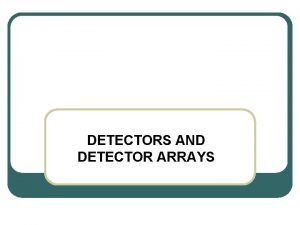Upgrade of liquid xenon gammaray detector in MEG

- Slides: 1

Upgrade of liquid xenon gamma-ray detector in MEG experiment Daisuke Kaneko, the University of Tokyo, on behalf of the MEG collaboration INTRODUCTION We are searching for the μ → e +γ decay in the MEG experiment at Paul Scherrer Institute in Switzerland with an unprecedented sensitivity. In order to achieve a higher sensitivity, we plan to upgrade the experiment, including an upgrade of the liquid xenon γ-ray detector with MPPC readout. It turned out by a simulation that the energy and position resolution will be significantly improved especially for events where γ-ray converts at a shallow part of the detector. UV-sensitive MPPC is under development to detect liquid xenon scintillation light in VUV range. Design and expected performance of the upgraded LXe detector and R&D status of UV-sensitive MPPC are presented MEG EXPERIMENT liquid xenon detector stopping target μ+ DC beam ・Modification in lateral PMT arrangement γ-ray Upgraded CG image Slant angle for better uniformity γ MPPC (12 mm) Wider inner face to reduce energy leakage Upgraded We set the current most stringent upper limit of branching ratio, 2. 4× 10 -12 at 90% CL. in year 2011. γ Comparison of light distribution of scintillation light, imaging power will be greatly improved Phys. Rev. Lett. , 107: 171801, 2011 We are aiming at ~6× 10 -13 as our goal for first stage of MEG experiment. (Year 2013) Further one-order improvement is expected in upgraded experiment. (Run start in Year 2016) aimed for 2013 goal of upgrade MEG Present MPPC Present In order to reject accidental background and thus to achieve high sensitivity, good resolutions are required for γ detector. timing counter PMT ・Smaller, square PMT ・Flat panel PMT Signal is 52. 8 Me. V γ-ray and 52. 8 Me. V e+ emitted back-to-back simultaneously. γ → Liquid Xenon Detector e+ → Drift Chamber → Timing Counter e+ drift chamber ・Replace current 2” PMTs on incident face with smaller candidates・MPPC photosensors μ → e + γ is suppressed in the standard model (~10 -50), but sizable probability (~10 -12~14) is predicted in many promising theories beyond the standard model. γ COBRA magnet with gradient magnetic field Concept of LXe Detector Upgrade MEG is searching for the lepton flavor violating decay, μ → e + γ. Development of UV-sensitive MPPC is under development in collaboration with Hamamatsu. MEG upgrade proposal to PSI is approved in Jan. 2013. ar. Xiv: 1301. 7225 [physics. ins-det] Annu. Rev. Nucl. Part. Sci. 2008. 58: 315 -41 W. J. Marciano, T. Mori, and J. M. Roney Improve sensitivity to xenon scintillation (λ: 175± 5 nm) commercially available products don’t have sensitivity to UV-light possible solutions Performance of Upgraded Detector We evaluated performance of the upgraded xenon detector by Monte Carlo simulation. Energy Resolution Position Resolution Red : present Blue : upgraded σup 2. 1% ↓ 0. 6% σup 1. 0% ↓ 0. 5% Red : PMT (present) Blue : MPPC (upgraded) Depth [cm] • Position resolution will also be improved at shallow part. Signal γ-ray spectra, left and right correspond to shallow and deep part respectively. Engineering Design • Detection efficiency improves by 9%, thanks to small thickness of MPPC. ・Remove protection layer ・Reduce thickness of contact layer ・Anti reflection coating ・Refractive index of sensor surface better matched to LXe Cross-sectional image of MPPC Position resolution in σ [mm] • Energy resolution will be greatly improved. sensor coverage becomes more uniform especially at shallow position with small sensors. Large-area MPPC With 12 x 12 mm 2 active region, currently 3 x 3 mm 2 is the largest commercial model, however it is too small for MEG γ detector. ・~4000 channels will be needed to fill inner face. (216 channels, currently) → high density vacuum feedthrough is required. (see below ”PCE vacuum feedthrough”) ・signal waveform become wider due to larger capacitance → parameter optimization is needed smaller pixel, lower quench resistance PCB vacuum feedthrough Signal transmittance in long cables In. order to transmit more channels, we are developing PCB feedthrough In actual xenon detector, signal must go through about 10 m before readout electronics. Deterioration by different cable length is tested, and it turn out to be moderate. Detector Assembly MPPCs will be mounted on long PCB, and the PCBs will be attached on inner face of xenon cryostat with thin metal wires. • Timing resolution is expected to be the same as current detector. quartz protection Detector assembly image ・Vacuum tightness ・Signal transmittance were confirmed MMCX connectors Coaxial like pattern is printed. Characteristic impedance 50Ω molded with epoxy Performance of UV-sensitive MPPC Temperature dependence of Gain & PDE We succeeded to detect UV light with large-area (12 x 12 mm 2) MPPC Gain & PDE depend on temperature, due to the shift of breakdown-voltage. Photon Detection Efficiency (PDE) 20% 18% 16% 14% 12% 10% 8% 6% 4% 2% 0% Since MPPC signals contain effect of Cross Talk & After Pulse, PDE is corrected with its probability measured separately. 3 mm sample 12 mm sample AP + CT Probability PDE is measured from scintillation photon from α-source. Currently, the most sensitive model has PDE about 17%, which enables us to detect more photons with the upgraded detector than those with the current detector 35% 20% 15% 0, 5 1 1, 5 2 Over Voltage[V] MPPCs on PCB 0% 0 0, 5 1 1, 5 Over Voltage [V] 2 241 Am α source PMT Single Photon Countability 1 photo-electron and 2 photoelectron evens can be resolved. gain slope 2%/K PDE slope 5%/K The effect is small since LXe temperature is highly stabilized. antireflection cylinder 10% 5% 0 12 x 12 mm 2 MPPC mounting board 3 mm sample 1 3 mm sample 2 12 mm sample 30% ← In commercial MPPC, most photons are absorbed by protection coating on surface. In addition, contact layer have little sensitivity because E field is weak in the layer. setup inside xenon chamber Dark count rate In liquid Xe temp. (165 K), thermal dark noise of MPPC is ~105 times lower than that in room temperature. This noise level is acceptable for our detector even at larger samples. SUMMARY • MEG Liquid xenon detector will be upgraded with MPPC • The performance of upgraded detector is being confirmed in MC simulation. • MPPCs sensitive to LXe scintillation is under development, enough high PDE (~17%) is already obtained PROSPECTS • Optimization of MPPC performance is still in progress • Further performance improvement is anticipated with recent breakthrough in HPK MPPC technology (HPK presentation @ IEEE 2012) 3 x 3 mm sample • We are planning a prototype test with hundreds of MPPCs in 2013 • Detector construction will start in 2014

